Deterministic Propagation Modeling for Intelligent Vehicle Communication in Smart Cities
Abstract
:1. Introduction
2. Materials and Methods
2.1. The Ray Launching Technique
2.2. Urban Scenario Description
2.3. Experimental Measurements
3. Simulation Results
3.1. Large Scale Spatial Path Loss
- -
- -
- and are the gain of RT and RX respectively.
- -
- is the free space path loss (reference distance = 1 m), defined by Equation (2):
- -
- is the wavelength, where and
- -
- is the close-in distance from the TX (considered 1 m).
- -
- is a zero-mean Gaussian distributed random variable with standard deviation σ.
- -
- is the TX–RX distance.
- -
- n, is the path loss exponent (PLE) and together with the standard deviation (STD) were estimated from the 3D-RL raw data, using Maximum Likelihood (ML) [35], according Equations (3) and (4):
3.2. Received Signal Strength
Coverage
- -
- TX1 and TX2 in the same simulated placement to give coverage to AV1, AV2, ST1.
- -
- Tree additional TXs: one for coverage of ST2, one for coverage of ST3 and, one for coverage the roundabout, AV3, AV4 and AV5 areas.
3.3. Multipath Metrics
3.3.1. Power Delay Profile (PDP)
3.3.2. Mean Excess Delay, RMS Delay Spread, and Coherence Bandwidth (CB)
3.3.3. Doppler Spread (BD) and Doppler Shift (fd)
4. Statistical Analysis
5. Measurements Results
5.1. Throughput Analysis in V2V and V2I Links
5.2. Packets Loss and Jitter
6. Application
7. Conclusions and Future Work
Author Contributions
Funding
Conflicts of Interest
References
- United States Department of Transportation (U.S. DOT). Smart Columbus: Systems Engineering Management Plan for the Smart Columbus Demonstration Program; U.S. DOT: Washington, DC, USA, 2018.
- Shen, L.; Du, L.; Yang, X.; Du, X.; Wang, J.; Hao, J. Sustainable Strategies for Transportation Development in Emerging Cities in China: A Simulation Approach. Sustainability 2018, 10, 844. [Google Scholar] [CrossRef]
- United States Department of Transportation (USDOT). Vehicle-to-Infrastructure (V2I) Resources. Available online: https://www.its.dot.gov/v2i/index.htm (accessed on 30 April 2018).
- The Institute of Electrical and Electronics Engineers. IEEE Std 802.11 p-2010. Part 11: Wireless LAN Medium Access Control (MAC) and Physical Layer (PHY). Specifications-Amendment 6: Wireless Access in Vehicular Environments; The Institute of Electrical and Electronics Engineers: New York, NY, USA, 2010. [Google Scholar]
- IEEE Vehicular Technology Society. IEEE Standard for Wireless Access in Vehicular Environments (WAVE)—Multi-Channel Operation; IEEE-SA Standards Board, Ed.; IEEE Vehicular Technology Society: New York, NY, USA, 2016. [Google Scholar]
- United States Department of Transportation (U.S. DOT). Vehicle-to-Infrastructure (V2I) Communications for Safety. Available online: http://www.its.dot.gov/research_archives/safety/v2i_comm_safety.htm (accessed on 30 March 2018).
- WAYMO. Technology-We’re Building a Safer Driver that is Always Alert and Never Distracted. Available online: https://waymo.com/tech/ (accessed on 30 April 2018).
- University of Michigan Transportation Research Institute-ITS Publications. Available online: http://www.umtri.umich.edu/our-focus/intelligent-transportation-systems (accessed on 4 February 2017).
- World Bank Group Intelligent Transport Systems—Toolkit for European Union. Available online: https://ppp.worldbank.org/public-private-partnership/library/intelligent-transport-systems-its-toolkit-european-union (accessed on 30 April 2018).
- U.S. Department of Transportation USDOT. Vehicle-to-Infrastructure (V2I) Safety Applications. Concept of Operation Document; USDOT: Washington, DC, USA, 2013.
- Raut, S.B.; Malik, L.G. Survey on vehicle collision prediction in VANET. In Proceedings of the 2014 IEEE International Conference on Computational Intelligence and Computing Research, Coimbatore, India, 18–20 December 2014; pp. 735–751. [Google Scholar]
- Basma, F.; Tachwali, Y.; Refai, H.H. Intersection collision avoidance system using infrastructure communication. In Proceedings of the 14th International IEEE Conference on Intelligent Transportation Systems (ITSC), Washington, DC, USA, 5–7 October 2011; pp. 422–427. [Google Scholar]
- Sommer, C.; Dressler, F. Vehicular Networking; Cambridge University Press: Cambridge, UK, 2015. [Google Scholar]
- Milanes, V.; Shladover, S.E.; Spring, J.; Nowakowski, C.; Kawazoe, H.; Nakamura, M. Cooperative adaptive cruise control in real traffic situations. IEEE Trans. Intell. Transp. Syst. 2014, 15, 296–305. [Google Scholar] [CrossRef]
- Belyaev, E.; Vinel, A.; Surak, A.; Gabbouj, M.; Jonsson, M.; Egiazarian, K. Robust vehicle-to-infrastructure video transmission for road surveillance applications. IEEE Trans. Veh. Technol. 2014, 64, 2991–3003. [Google Scholar] [CrossRef]
- U.S. Department of Transportation (USDOT). Department of Transportation (USDOT). Transit Vehicle-to-Infrastructure (V2I) Assessment Study Project Report; USDOT: Washington, DC, USA, 2015.
- Aygun, B.; Boban, M.; Vilela, J.P.; Wyglinski, A.M. Geometry-based propagation modeling and simulation of vehicle-to-infrastructure links. In Proceedings of the IEEE 83rd Vehicular Technology Conference (VTC Spring), Nanjing, China, 15–18 May 2016; pp. 3–7. [Google Scholar]
- Viriyasitavat, W.; Boban, M.; Tsai, H.M.; Vasilakos, A. Vehicular communications: Survey and challenges of channel and propagation models. IEEE Veh. Technol. Mag. 2015, 10, 55–66. [Google Scholar] [CrossRef]
- Azpilicueta, L.; Vargas-Rosales, C.; Falcone, F. Deterministic Propagation Prediction in Transportation Systems. IEEE Veh. Technol. Mag. 2016, 11, 29–37. [Google Scholar] [CrossRef]
- Gozalvez, J.; Sepulcre, M.; Bauza, R. IEEE 802.11p Vehicle to Infrastructure Communications in Urban Environments. Top. Automot. Netw. Appl. 2012, 50, 176–183. [Google Scholar] [CrossRef]
- Boban, M.; Barros, J.; Tonguz, O.K. Geometry-Based Vehicle-to-Vehicle Channel Modeling for Large-Scale Simulation. IEEE Trans. Veh. Technol. 2014, 63, 4146–4164. [Google Scholar] [CrossRef] [Green Version]
- Matolak, D.W. Modeling the vehicle-to-vehicle propagation channel: A review. Radio Sci. 2014, 49, 721–736. [Google Scholar] [CrossRef] [Green Version]
- Bernado, L.; Zemen, T.; Tufvesson, F.; Molisch, A.F.; Mecklenbräuker, C.F. Time- and Frequency-Varying K-Factor of Non-Stationary Vehicular Channels for Safety-Relevant Scenarios. IEEE Trans. Intell. Transp. Syst. 2015, 16, 1007–1017. [Google Scholar] [CrossRef]
- Azpilicueta, L.; Rawat, M.; Rawat, K.; Ghannouchi, F.; Falcone, F. Convergence analysis in deterministic 3D ray launching radio channel estimation in complex environments. Appl. Comput. Electromagn. Soc. J. 2014, 29, 256–271. [Google Scholar]
- Lopez-Iturri, P.; Aguirre, E.; Trigo, J.; Astrain, J.; Azpilicueta, L.; Serrano, L.; Villadangos, J.; Falcone, F. Implementation and Operational Analysis of an Interactive Intensive Care Unit within a Smart Health Context. Sensors 2018, 18, 389. [Google Scholar] [CrossRef] [PubMed]
- Azpilicueta, L.; Iturri, P.L.; Aguirre, E.; Astrain, J.J.; Villadangos, J.; Zubiri, C.; Falcone, F. Characterization of Wireless Channel Impact on Wireless Sensor Network Performance in Public Transportation Buses. IEEE Trans. Intell. Transp. Syst. 2015, 16, 3280–3293. [Google Scholar] [CrossRef]
- Granda, F.; Azpilicueta, L.; Vargas-rosales, C.; Lopez-iturri, P.; Aguirre, E.; Astrain, J.; Villandangos, J.; Falcone, F. Spatial Characterization of Radio Propagation Channel in Urban Vehicle-to-Infrastructure Environments to Support WSNs Deployment. Sensors 2017, 17, 1313. [Google Scholar] [CrossRef] [PubMed]
- Azpilicueta, L.; Astrain, J.J.; Lopez-Iturri, P.; Granda, F.; Vargas-Rosales, C.; Villadangos, J.; Perallos, A.; Bahillo, A.; Falcone, F. Optimization and Design of Wireless Systems for the Implementation of Context Aware Scenarios in Railway Passenger Vehicles. IEEE Trans. Intell. Transp. Syst. 2017, 18, 2838–2850. [Google Scholar] [CrossRef]
- RedPine Signals. Driving Wireless Convergence. WaveCombo Module. 802.11p V2X. Available online: http://www.redpinesignals.com/Products/802.11p_V2X_Connectivity/802.11p_V2X_Module.php (accessed on 28 February 2018).
- Ublox VERA-P1 Series. Host-based V2X Transceiver Modules. Product Information. Available online: https://www.u-blox.com/en/product/vera-p1-series (accessed on 28 February 2018).
- Kapsch TrafficCom. In-Vehicle Products (5.9 Ghz). EVK-3300. V2X Evaluation Kit. Available online: https://www.kapsch.net/ktc/downloads/ (accessed on 28 February 2018).
- Science & Engineering Applications (SEA). SEA 9719 802.11p V2X Communication Module. Available online: https://www.sea-gmbh.com/produkte/testsysteme/v2x/ (accessed on 28 February 2018).
- Lindner, M.; Wunderlich, S.; Quartulli, A.; Lüssing, L.; Hundebøll, M.; Eckelmann, S. Open Mesh: Batman-Adv Project, B.A.T.M.A.N. Advanced Documentation Overview. Available online: https://www.open-mesh.org/projects/batman-adv/wiki#BATMAN-Advanced-Documentation-Overview (accessed on 12 May 2018).
- Rappaport, T. Wireless Communications: Principles and Practice, 2nd ed.; Communications Engineering and Emerging Technologies Series; Prenctice Hall, Ed.; Prentice Hall PTR: Upper Saddle River, NJ, USA, 2002. [Google Scholar]
- Mao, G.; Anderson, B.D.O.; Fidan, B. Path loss exponent estimation for wireless sensor network localization. Comput. Netw. 2007, 51, 2467–2483. [Google Scholar] [CrossRef]
- Bithas, P.S. Weibull-gamma composite distribution: Alternative multipath/shadowing fading model. Electron. Lett. 2009, 45, 749. [Google Scholar] [CrossRef]
- Atapattu, S.; Tellambura, C.; Jiang, H. Representation of composite fading and shadowing distributions by using mixtures of gamma distributions. In Proceedings of the IEEE Wireless Communication and Networking Conference, Sydney, Australia, 18–21 April 2010. [Google Scholar]
- Rehman, N.U.; Naveed, K.; Ehsan, S.; McDonald-Maier, K. Multi-scale image denoising based on goodness of fit (GOF) tests. In Proceedings of the 24th European Signal Processing Conference (EUSIPCO), Budapest, Hungary, 29 August–2 September 2016; pp. 1548–1552. [Google Scholar]
- Wang, H.; Yang, E.-H.; Zhao, Z.; Zhang, W. Spectrum Sensing in Cognitive Radio Using Goodness of Fit Testing. IEEE Trans. Wirel. Commun. 2009, 8, 5427–5430. [Google Scholar] [CrossRef]
- Zeng, X.; Wang, D.; Wu, J. Evaulating the Three Methods of Goodness of Fit Test for Frequency Analysis. J. Risk Anal. Cris. Response 2015, 5, 178–187. [Google Scholar] [CrossRef]
- Abdi, H. Coefficient of Variation; Salkind, N.J., Dougherty, D.M., Frey, B., Eds.; John Wiley & Sons, Inc.: New York, NY, USA, 2010; pp. 169–171. [Google Scholar]
- Charash, U. Reception through Nakagami Fading Multipath Channels. Commun. IEEE Trans. 1979, 27, 645–670. [Google Scholar] [CrossRef]
- Liebscher, E. Approximation of distributions by using the Anderson Darling statistic. Commun. Stat. Theory Methods 2016, 45, 6732–6745. [Google Scholar] [CrossRef]


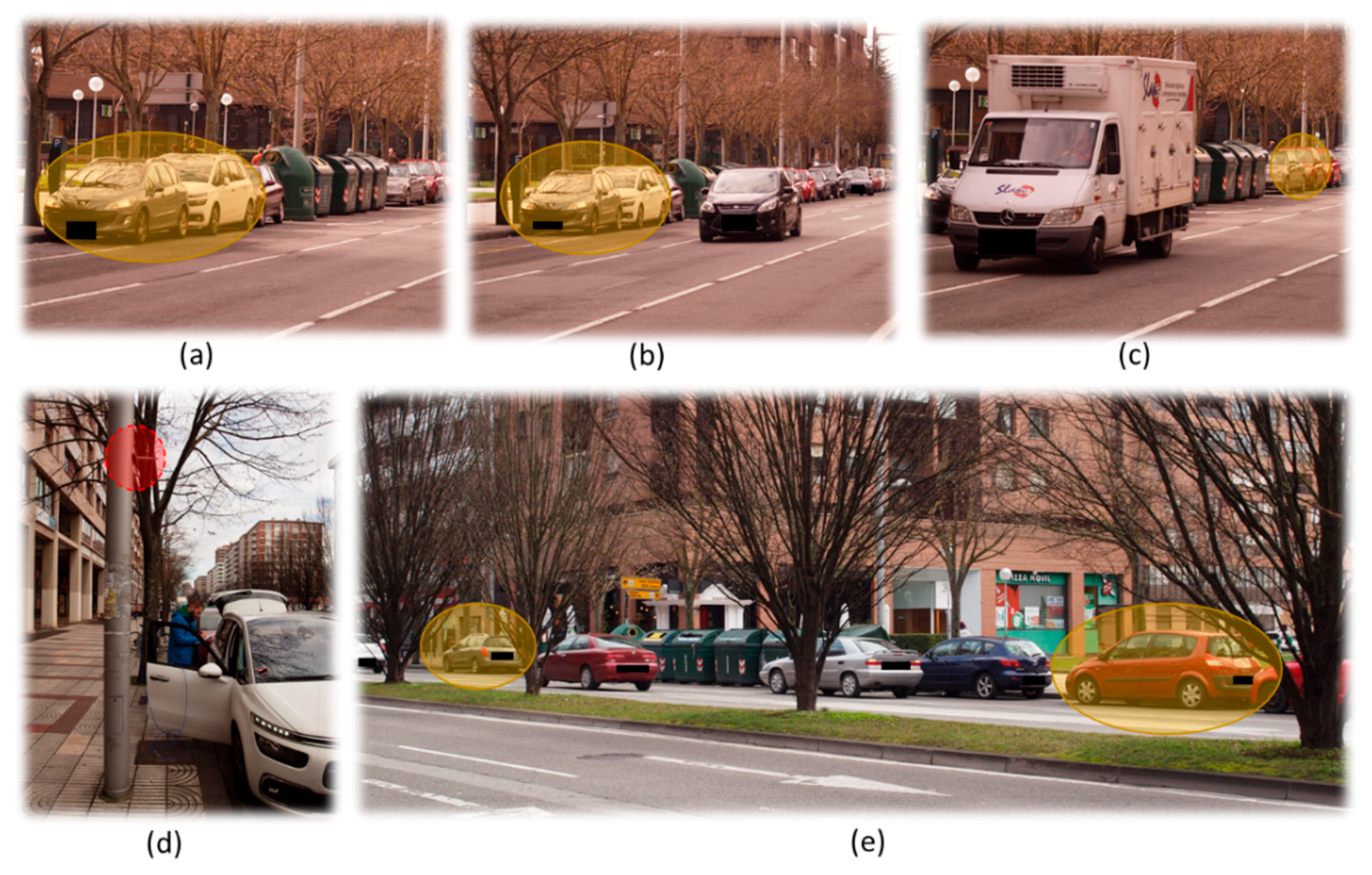
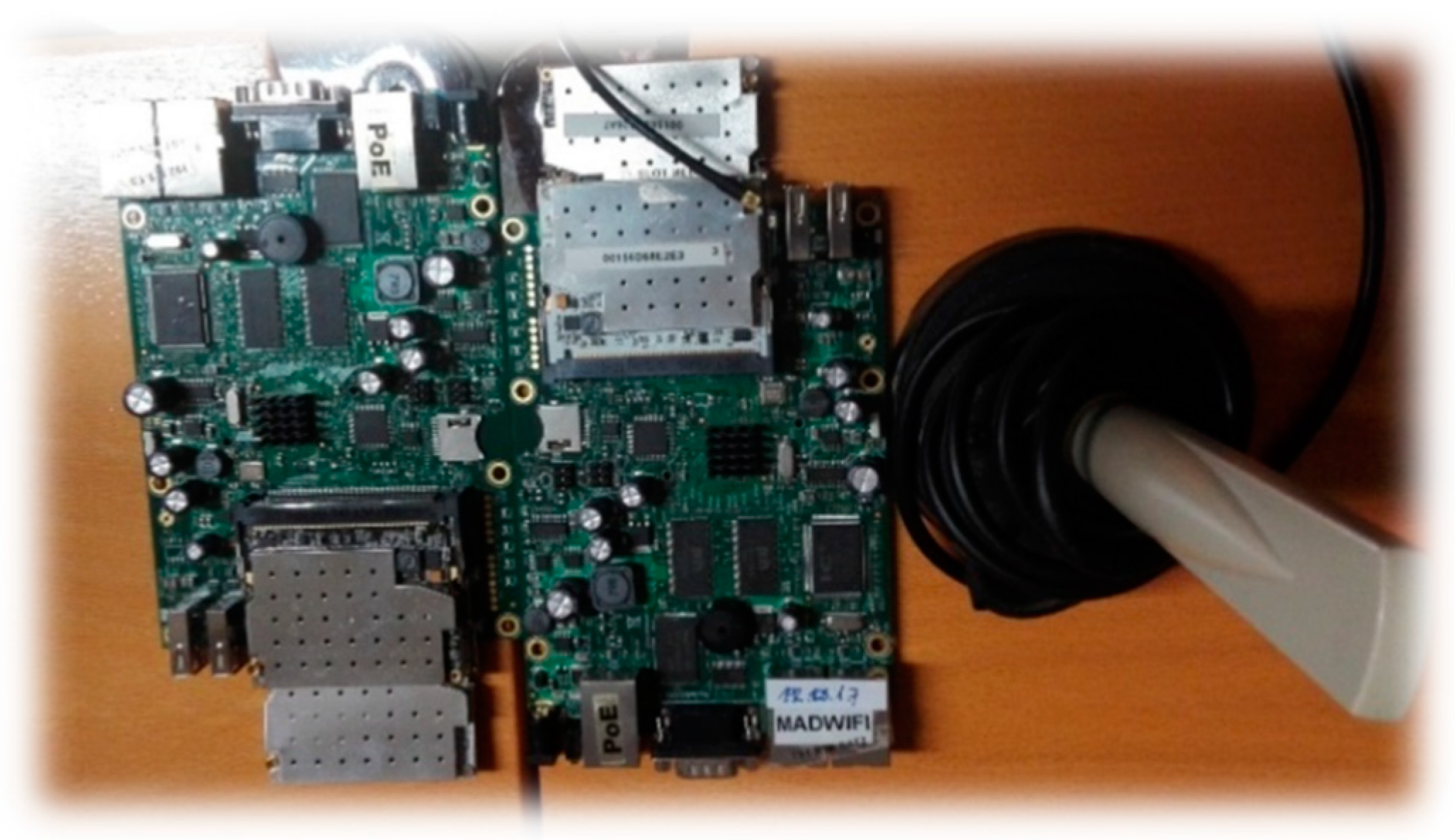
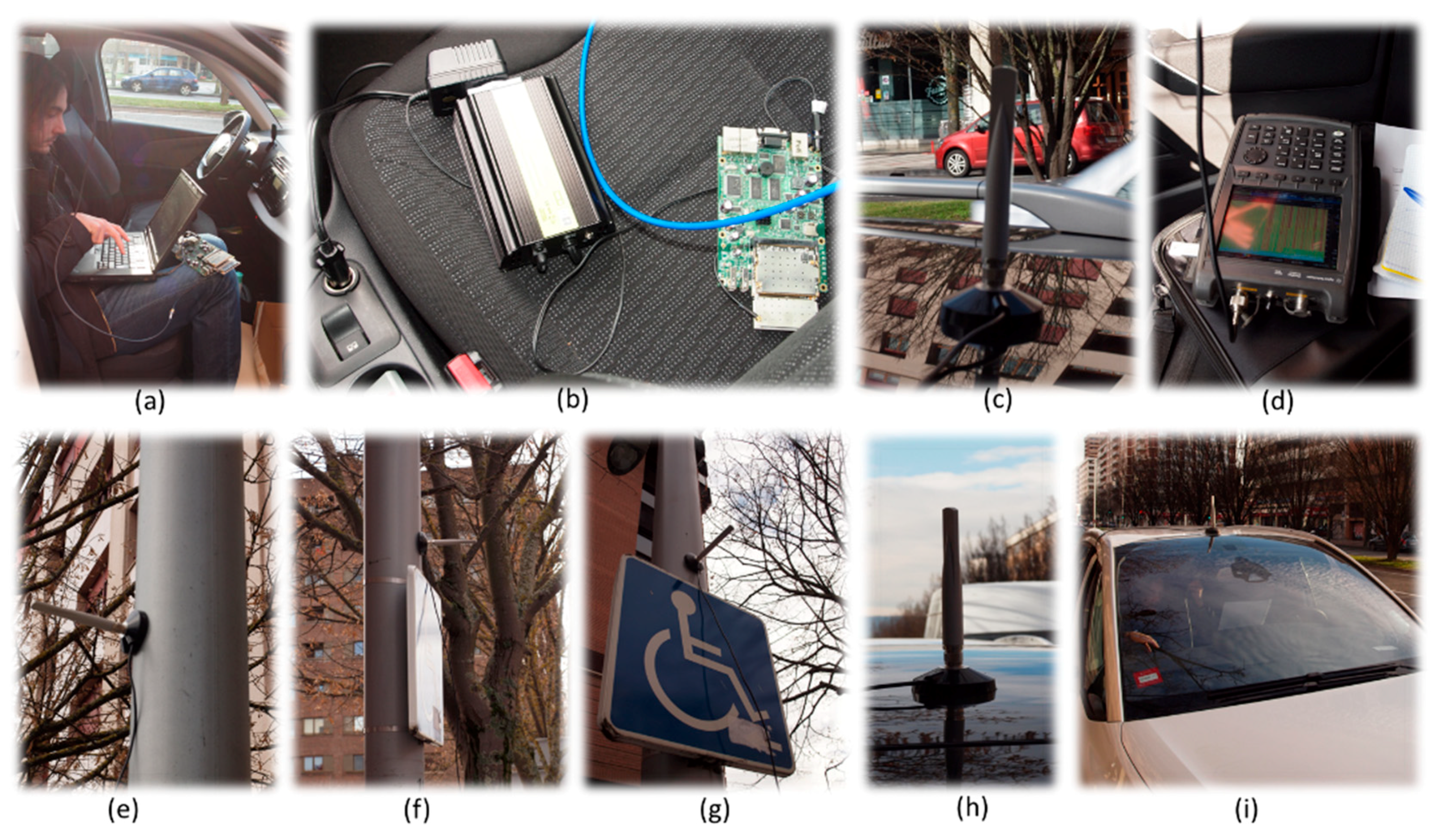





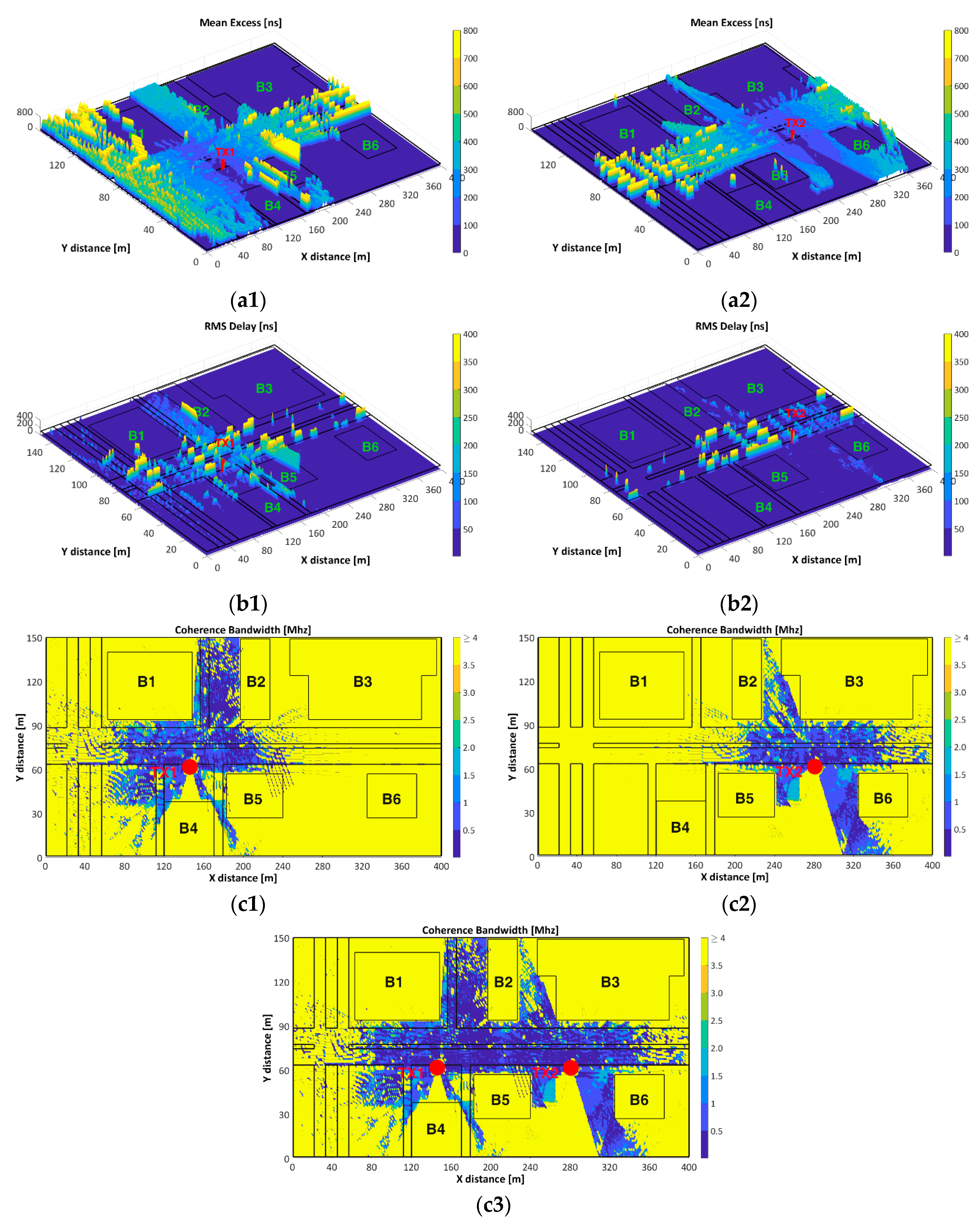




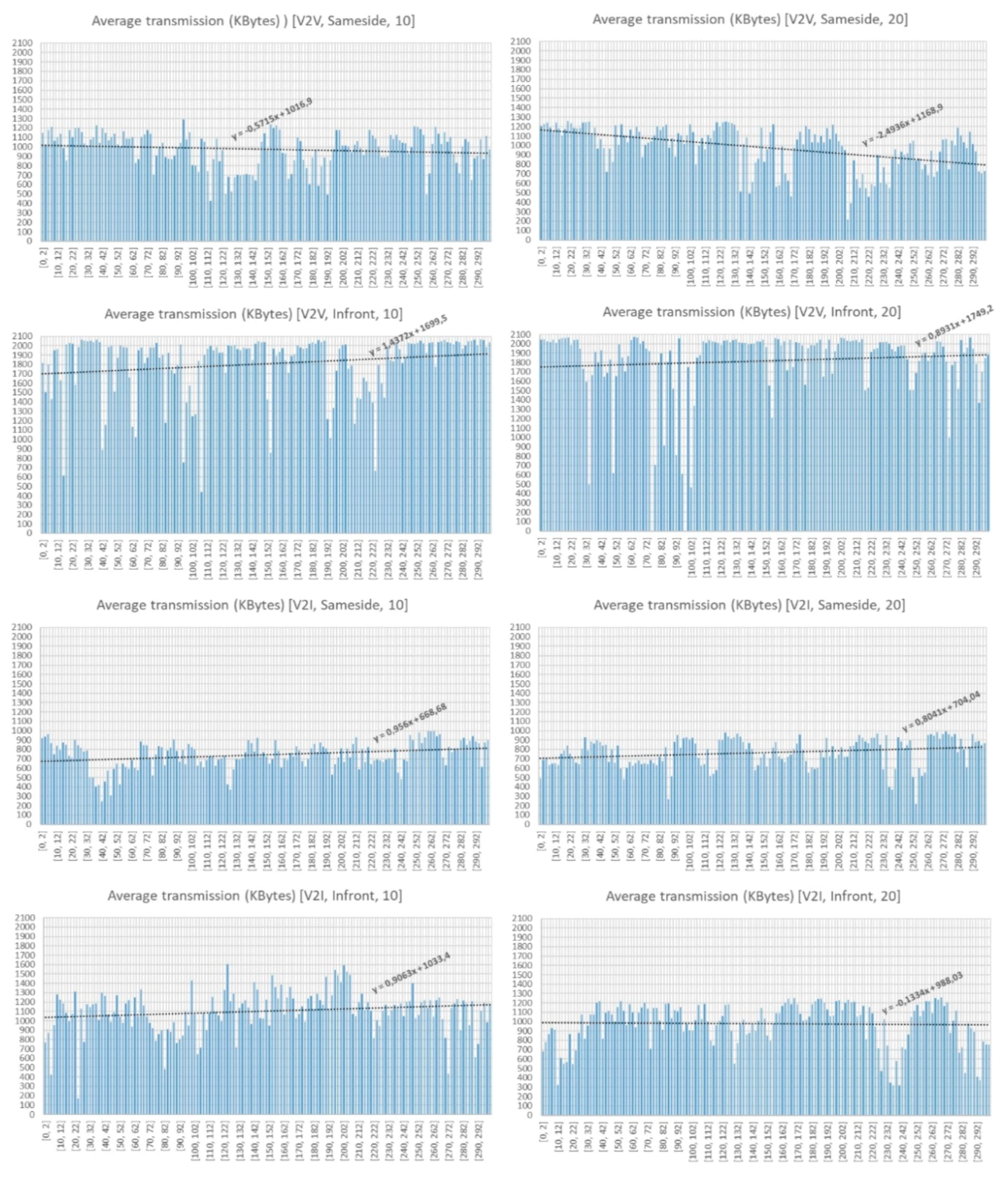


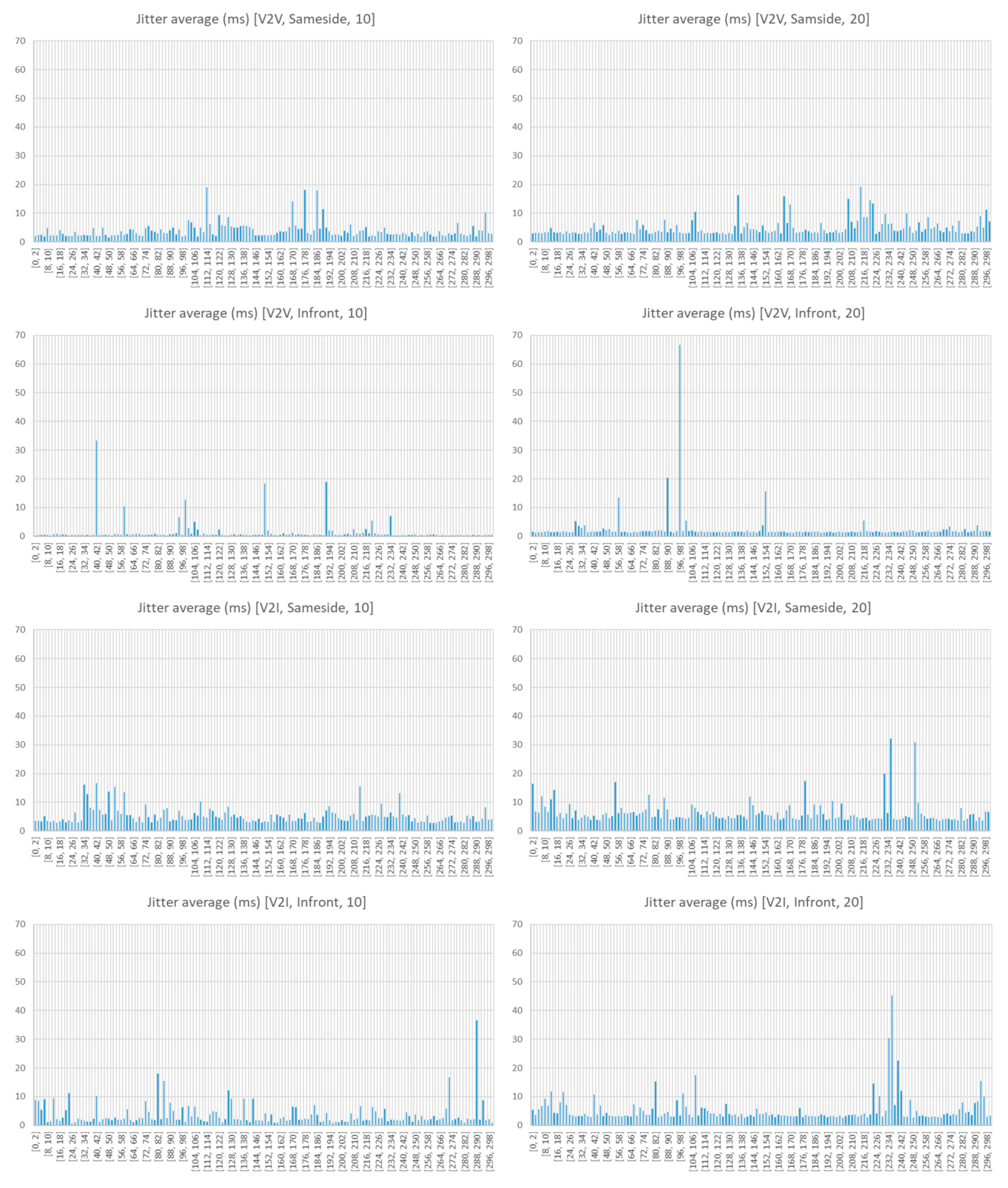


| Reference | Abbreviation | Coordinates (x, y, z) m |
|---|---|---|
| Main Avenues | AV1/AV2 | (x, 83, 0)/(x, 69, 0) |
| Streets | ST1/ST2/ST3 | (161, y, 0)/ (117, y, 0)/ (175, y, 0) |
| Transmitter antenna (TX) | TX1/TX2 | (146, 63, 3.5)/(281, 63, 3.5) |
| Receiver antenna (RX) | RX | (x, y, 1.5) |
| Buildings | B1, B2, B3, B4, B5, B6 | Not applicable. |
| Parameters | Values |
|---|---|
| TX1, TX2: | |
| */)/Frequency/Height/ polarization. | 0 dBm/0 dB/5.9 Ghz/3.5 m omnidirectional. |
| RX: RST **//Frequency/Height. | −100 dBm/0 dB/5.9 Ghz/1.5 m |
| /polarization. | omnidirectional. |
| 3D-RL: horizontal and vertical angular resolution | π/180 rad |
| Angular resolution of diffracted rays. | π/20 rad |
| Maximum permitted reflections. | 7 hops |
| Cuboid segmentation for analysis. | 1 m3 (1 × 1 × 1) m |
| Scenario: dimension. | (400 × 150 × 22) m |
| Description | PLE (n) | STD (σ) [dB] |
|---|---|---|
| (a) Along AV1 (y = 81 m) | ||
| x: (0 to AV5/AV5 to TX1/TX1 to TX2/TX2 to 400) m | (2.8/2.5/2.8/4.3) | (30.8/13.1/25.1/44.6) |
| (b) Along AV2 (y = 70 m) | ||
| x: (0 to AV5/ AV5 to TX1/TX1 to TX2/ TX2 to 400) m | (2.6/2.4/2.5/5.0) | (20.1/11.3/18.0/44.0) |
| (c) Along ST1 (x = 161 m) | ||
| y: (AV2 to 150) m | 2.40 | 9.21 |
| (d) Along ST2 (x = 116 m) | ||
| y: (LoS: 1 to 21/NLoS: 21 to AV1) m | (4.13/ 2.48) | (11.32/8.11) |
| (e) Along ST3 (x = 178 m) | ||
| y: (LoS: 1 to 21/NLoS: 21 to AV1) m | (4.21/2.28) | (15.56/3.36) |
| Description | SCV ** | n *** | Lognormal | Gamma | Nakagami | Weibull |
|---|---|---|---|---|---|---|
| (a) S1: (x: 1 to 60) m | 1.126 | 3.099 | ||||
| CDF-GOF: AD * (Hypothesis test/statistic) Input parameter: Shape | F/1.817 0.072 | T/8.029 1.210 | T/19.552 0.391 | T/7.485 1.058 | ||
| (b) S2: (x: 60 to 120) m | 1.715 | 2.345 | ||||
| AD (Hypothesis test/statistic) Shape factor | T/3.951 1.136 | T/3.558 0.842 | T/23.013 0.289 | F/1.936 0.870 | ||
| (c) S3: (x: 120 to 146) m | 8.473 | 2.449 | ||||
| AD (Hypothesis test/statistic) Shape factor | F/1.051 3.466 | T/20.25 0.396 | T/44.186 0.139 | T/7.9071 0.541 | ||
| (d) S1, S2, S3, S4 (x: 1 to 146) m AD (Hypothesis test/statistic) | 34.268 | 2.764 | T/11.261 | T/Inf | T/Inf | T/70.462 |
| (e) S5, S6, S7 (x: 146 to 290) m AD (Hypothesis test/statistic) | 27.526 | 3.041 | T/0.313 | T/4.544 | T/46.353 | T/2.495 |
| (f) S6: (x:146 to 170) m | 6.691 | 2.377 | ||||
| AD (Hypothesis test/statistic) Shape factor | F/0.878 3.987 | T/19.259 0.479 | T/46.353 0.161 | T/8.437 0.609 | ||
| (g) S7: (x: 170 to 230) m | 1.826 | 2.284 | ||||
| AD (Hypothesis test/statistic) Shape factor | F/1.639 1.507 | T/7.946 0.827 | T/34.403 0.282 | T/4.809 0.855 | ||
| (h) S8 (x: 230 to 290) m | 1.225 | 3.610 | ||||
| AD (Hypothesis test/statistic) Shape factor | F/1.342 0.013 | T/4.658 1.149 | T/18.919 0.370 | T/4.668 1.029 |
© 2018 by the authors. Licensee MDPI, Basel, Switzerland. This article is an open access article distributed under the terms and conditions of the Creative Commons Attribution (CC BY) license (http://creativecommons.org/licenses/by/4.0/).
Share and Cite
Granda, F.; Azpilicueta, L.; Vargas-Rosales, C.; Celaya-Echarri, M.; Lopez-Iturri, P.; Aguirre, E.; Astrain, J.J.; Medrano, P.; Villandangos, J.; Falcone, F. Deterministic Propagation Modeling for Intelligent Vehicle Communication in Smart Cities. Sensors 2018, 18, 2133. https://doi.org/10.3390/s18072133
Granda F, Azpilicueta L, Vargas-Rosales C, Celaya-Echarri M, Lopez-Iturri P, Aguirre E, Astrain JJ, Medrano P, Villandangos J, Falcone F. Deterministic Propagation Modeling for Intelligent Vehicle Communication in Smart Cities. Sensors. 2018; 18(7):2133. https://doi.org/10.3390/s18072133
Chicago/Turabian StyleGranda, Fausto, Leyre Azpilicueta, Cesar Vargas-Rosales, Mikel Celaya-Echarri, Peio Lopez-Iturri, Erik Aguirre, Jose Javier Astrain, Pablo Medrano, Jesus Villandangos, and Francisco Falcone. 2018. "Deterministic Propagation Modeling for Intelligent Vehicle Communication in Smart Cities" Sensors 18, no. 7: 2133. https://doi.org/10.3390/s18072133
APA StyleGranda, F., Azpilicueta, L., Vargas-Rosales, C., Celaya-Echarri, M., Lopez-Iturri, P., Aguirre, E., Astrain, J. J., Medrano, P., Villandangos, J., & Falcone, F. (2018). Deterministic Propagation Modeling for Intelligent Vehicle Communication in Smart Cities. Sensors, 18(7), 2133. https://doi.org/10.3390/s18072133











